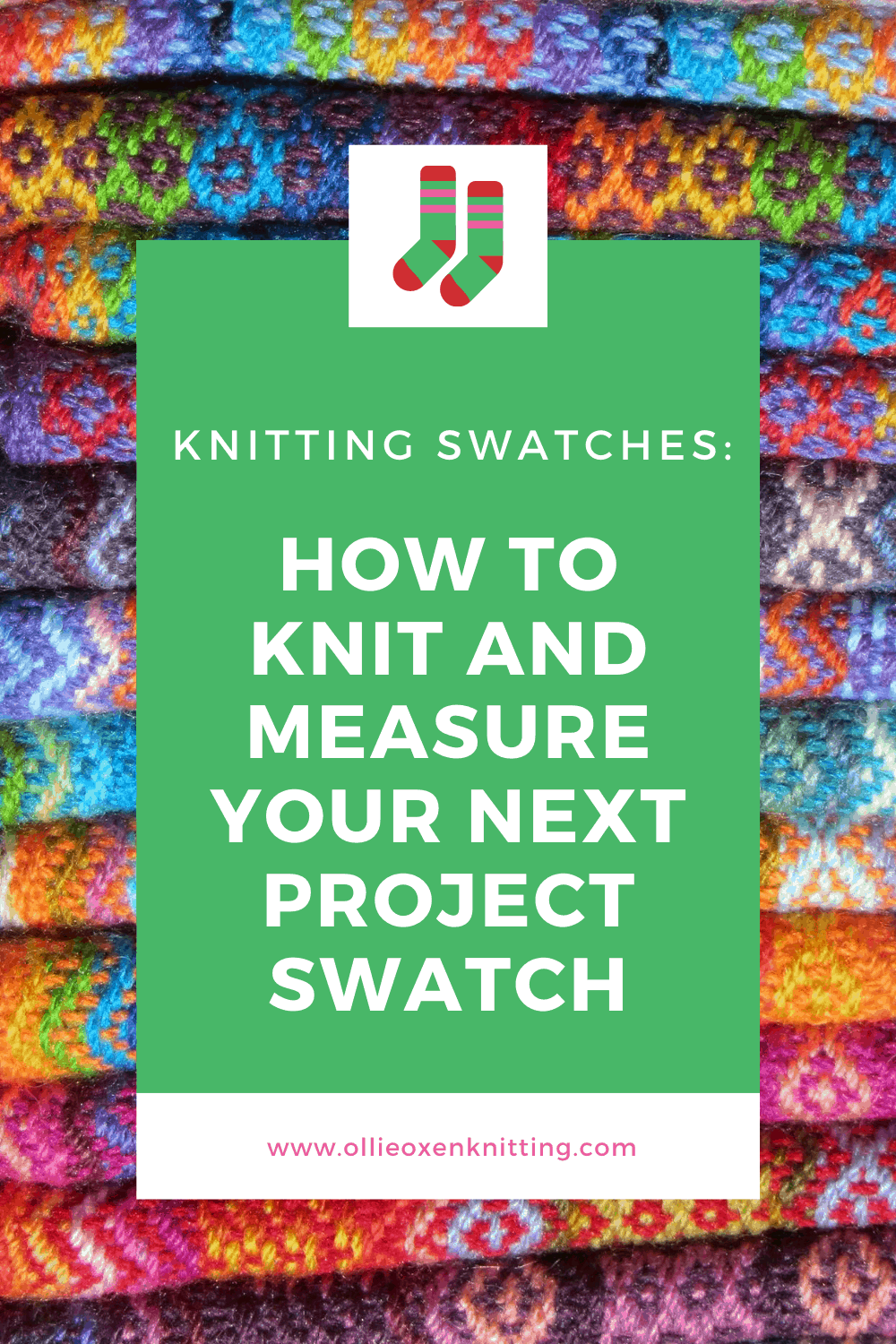First off, you gotta know what a swatch is! A swatch is a small test of how your pattern, needles, and yarn come together to create your gauge. This gives you a good idea of whether or not you’ll like the project. Without a swatch, you’re pretty much knitting in the dark.
Since no two knitters are alike, gauge is a magical tool for measuring a knitter’s tension. This makes achieving consistent results possible. Understanding your gauge is what makes it so that a different knitter, using different needles, and different yarn, can still make a garment that fits.
To Swatch or Not To Swatch?
Time to be honest. I don’t often, no, I rarely, knit a swatch. I just don’t personally care enough to knit one 99% of the time. If my dishcloths come out too big, oh well. My dishes won’t care. If my socks are too small, that’s alright. My sister has tiny feet. I tend to enjoy the journey of the project more than the end product. That’s not to say I haven’t paid the price (more than) a time or two.
*INSERT GIF tiny sweater being forced on Caption: Been there, done that.*
That being said, certain yarns are VERY hard to guesstimate. Some cottons, for example, when knit at too loose of a gauge, will stretch out far beyond their expected size. With things like sweaters or heirloom quality items, I will knit a swatch. Sometimes several until I get the result I want. Add funny comment here?
If you’re like me and resist swatching for some odd reason, my biggest bit of advice is to find a way to treat the swatch like it’s own project. If I’m making something flat out of plant fibers, I try to view the swatch as a dishcloth that I’ll be giving away to someone at an upcoming party. If I’m making something flat out of animal fibers, I’ll treat the swatch like a blanket square* to add to my collection. If I’m making something in the round out of plant fibers, I’ll make an artistic beanie. If I’m making something in the round out of animal fibers, I’ll make a beanie. If I’m making a sweater, I make a really tiny mini version for a baby. Even if my gauge is way off or I end up not liking the pattern, I still end up with a finished project.
*INSERT VISUAL infographic of the paragraph above Caption: No matter what happens, it’s a win-win!*
*Cool story: If you make your swatches in a standard blanket square size, you can have a whole blanket of you past projects. A lot of knitters give their projects away so this is a nice way to hold onto the memories. If that’s not your style, you can donate the squares. There are a number of charities that are always in need of blanket squares. You simply ship them to the coordinator, they stitch them up, and mail out a completed blanket to someone in need. How neat is that?
How To Knit A Swatch
Now that we know why swatches are important, let’s learn how to make one.
If you’re going to create a hat or baby sweater instead of a traditional swatch, knit that and skip down to the next section. If you’re going to make a blanket square for donation, aim for numbers that will give you a blanket square 8”x8” (20cmx20cm) as this seems to be the most common size requested.
Are you ready for some math? Don’t worry, you’ll be a pro in no time! Let’s pretend that your pattern says that with worsted weight yarn and size 8 needles, you should get a gauge of 20 sts / 28 rows = 4 inches in stockinette. This means that you need to knit an absolute minimum of 20 stitches and 28 rows in order to create your gauge. It’s always best to have more fabric to work with so even if you’re just knitting a regular ol’ swatch (not a blanket square), your swatch should be, at a minimum, 5 inches square to get an accurate reading.
Conveniently, it’s standard for knitting patterns to give gauge for 4 inches and since most blanket square are 8”, all you’ll ever need to do is double your stitch and row count to get the numbers for your blanket square/swatch thingy. So for our example, in order to get a square that is 8” wide, you’ll need to cast on 40sts. (Since you want a square that is twice as long as the gauge given, you take 20sts and multiply by 2). To get a swatch that is 8” long, you’ll need to knit 56 rows. (Take 28 rows and multiply by 2).
Now that we know our basic numbers, you can cast on. Personally, I like using the Long Tail Cast On because I feel like it holds up the best. Work the first and last 4-6 rows in garter stitch. We’re also going to use the garter stitch pattern for 4 stitches on both edges of the swatch. This will help your swatch to lay flat. After you’re done knitting your swatch, weave in your ends and let’s get to measuring!
*INSERT PICTURE of correct swatch. Caption: Tada! Now Let’s get out those rulers!*
*Cool tip! On the first row of plain stockinette, purl your needle size into the middle of the swatch. So if you’re using a size 8 needle, purl 8 stitches in the center of your swatch just on the bottom row. This way, if you ever lose your notes, the answer is right there on the swatch. You just need to count the number of purl bumps. Since you’ll be knittig the bottom of the swatch in garter, this won’t be very visible. Pretty neat, hu?
How To Measure Gauge
Time to measure the swatch! Get out your ruler, lay your swatch flat on a sturdy surface, and line it up going across the project like this:
*insert picture*
We’re going to be counting stitches over four inches. You simply count all of the “V”s. If you have a knit stitch that is cut off, round to the nearest quarter. This is important! Make sure to not stretch or scrunch your knitting as you measure.
For example, you might have 24.25 or 22.5. Next we’re going to do the exact same thing with the rows. Make sure that you jot these numbers down along with the needle size used and total number of stitches cast on. Do this several times in multiple areas in the heart of your swatch and write down the average*.
*INSERT INFOGRAPHIC (See info below)*
*Just a quick math refresher: “Average” is a math term that means you add multiple groups together than divide that number by the total number of groups. As an example, I measured my swatch three times in three different places. I got 20sts, 20.5sts, and 19.5.
*Insert graphic here? (20) + (20.5) + (19.5) = 60.
Now I take my total and divide it by the number of groups, in this example that would be the 3 since I measured my swatch 3 times.
60 / 3 = 20.
Tada! My average stitch count is 20.
Now that you’ve measured your swatch gauge, you’ll need to repeat the process after washing and drying your swatch. It’s important to treat your swatch exactly like you’ll treat your finished project so that you’ll get the most accurate gauge possible. Yarn can look and feel drastically different after a good bath so it’s critical that you make sure that you like the way things will look after you wet your project.
Okay, now that your back with your swatch that has been washed and blocked, let’s measure your gauge again. Don’t forget to measure it several times in different places and to take the average.
Sometimes your gauge will not change after washing and that’s ok. What’s important is that the washed gauge matches the pattern gauge. If your numbers match, then you’re all set to start knitting your project! As you’re knitting, occasionally make sure your project gauge matches your swatch’s prewashed gauge. And just like that, you can rest assured that your project will come out the size that it is supposed to be.
Your Turn!
Do you have any swatch making tips and tricks? Let us know in the comment section down below!





